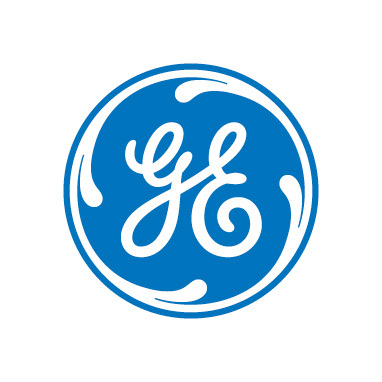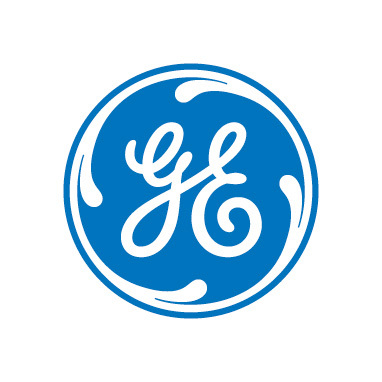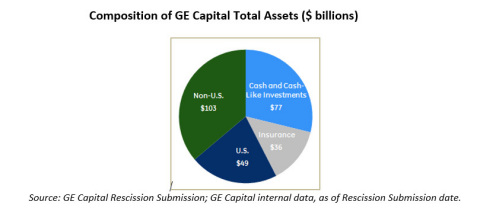FAIRFIELD, Conn.--(BUSINESS WIRE)--First sentence under second bullet point in the body of release should read: one-tenth of 1% of the market (instead of one-tenth of the market).
The corrected release reads:
GE CAPITAL FILES REQUEST FOR RESCISSION OF STATUS AS A SYSTEMICALLY IMPORTANT FINANCIAL INSTITUTION
- Major transformation of GE Capital to smaller, more focused firm
- GE Capital believes it does not pose any threat to financial system
GE (NYSE:GE) continues to quickly and successfully execute the transformation of GE Capital into a smaller, more focused financial services firm. Today, GE filed its request to the Financial Stability Oversight Council (FSOC) for rescission of GE Capital’s designation as a nonbank Systemically Important Financial Institution (SIFI).
The filing demonstrates that GE Capital has substantially reduced its risk profile and is significantly less interconnected to the financial system, and therefore does not pose any conceivable threat to U.S. financial stability. The request details the changes and dispositions GE Capital has made since being designated as a SIFI in 2013 and, in particular, since GE announced in April 2015 that it would become a more focused digital industrial company by dramatically reducing the size of GE Capital.
“Our submission details the complete transformation of GE Capital. Our plan to change our business model, shrink the Company and reduce our risk profile has been successful,” said GE Capital Chairman and CEO Keith Sherin. “We have completed over 80% of our projected asset reductions; exited leveraged lending and U.S. consumer lending; exited nearly all middle market lending; reduced real estate debt by more than 75% and real estate equity by 100%; and reduced outstanding commercial paper almost 90%."
“We believe GE Capital no longer meets the criteria to be designated as a SIFI and we look forward to working cooperatively and constructively with the FSOC through the rescission process,” added Sherin.
The key points in the application are as follows and are detailed further in the attached summary: (Beginning numbers are as of year-end 2012; ending numbers are as of the time of filing.)
-
GE Capital has completely transformed itself, primarily through the
sale or split-off of most of its legacy financial services businesses,
into a smaller, simpler company focused on customers and markets
aligned with GE’s industrial businesses.
-
GE Capital has reduced its assets 52%, from $549 billion to $265
billion. Of the remaining $265 billion in assets:
- $77 billion are cash and cash-like investments
- $36 billion are assets related to run-off U.S. insurance activities
-
$153 billion are therefore non-cash, non-insurance related
assets;
only ~$50 billion of these assets are in the U.S.
-
Financing receivables are down 74%, from $277 billion to $72
billion.
Loans secured by real estate are down 77%, from $72 billion to $17 billion; in the U.S., this is down to $5 billion. - Loans to consumers are down 95%, from $72 billion to $4 billion; in the U.S., loans to consumers are down to $0.
- Meanwhile, cash and cash-like investments are up 35%, from $57 billion to $77 billion.
-
GE Capital has reduced its assets 52%, from $549 billion to $265
billion. Of the remaining $265 billion in assets:
-
GE Capital has materially reduced its use of short-term and
securitization funding.
- Commercial paper (CP) is down 88%, from $43 billion outstanding to $5 billion, taking it from being the top issuer of U.S. CP to representing less than one-tenth of 1% of the market.
- Securitization funding is down 90%, from $30 billion to $3 billion.
- GE Capital does not plan to issue any incremental debt for the next four years. GE also assumed or guaranteed all of GE Capital’s unsecured debt, which mitigates the likelihood of and reduces the impact if GE Capital were to experience financial distress.
- GE Capital has exited one of its U.S. bank charters through the completed split-off of Synchrony Financial and regulatory approval has been granted for the sale of its U.S. deposit business to Goldman Sachs. The sale and the surrender of that second bank charter should be completed by April 30, 2016, after which GE Capital will no longer own any banks with deposits insured by the Federal Deposit Insurance Corporation.
- Through numerous dispositions and the Synchrony Financial split-off, GE Capital has exited all leveraged lending, all consumer lending in the U.S., most consumer lending in the E.U., and nearly all middle market lending and commercial real estate financing globally. Its current (and future remaining) businesses do not provide a critical function to the economy that could not easily be supported by other entities.
-
GE Capital has simplified and rationalized its structure and completed
a significant reorganization. These changes have reduced its
complexity and enhanced its resolvability.
- GE Capital’s regulated operations are now centered in Europe. GE Capital has consolidated its non-U.S. operations into GE Capital International Holdings Limited, whose operations are and will be prudentially supervised by the U.K. Prudential Regulation Authority for as long as prudential regulation is required.
- Going forward, GE Capital will be focused on its vertical businesses which serve customers and markets aligned to GE’s industrial businesses: GE Capital Aviation Services, GE Energy Financial Services and GE Capital Industrial Finance, which includes Healthcare Equipment Finance and Working Capital Solutions. The go-forward portfolio composition and risk structure will be similar to that of other finance companies aligned with their industrial parents.
In sum, GE Capital believes it poses no threat to U.S. financial stability and, as of today, no longer meets the criteria for designation as a nonbank SIFI. GE Capital looks forward to working cooperatively with the FSOC on the request to rescind the SIFI designation.
About GE
GE (NYSE:GE) is the world’s Digital Industrial Company, transforming industry with software-defined machines and solutions that are connected, responsive and predictive. GE is organized around a global exchange of knowledge, the "GE Store," through which each business shares and accesses the same technology, markets, structure and intellect. Each invention further fuels innovation and application across our industrial sectors. With people, services, technology and scale, GE delivers better outcomes for customers by speaking the language of industry. www.ge.com
GE’s Investor Relations website at www.ge.com/investor and our corporate blog at www.gereports.com, as well as GE’s Facebook page and Twitter accounts, including @GE_Reports, contain a significant amount of information about GE, including financial and other information for investors. GE encourages investors to visit these websites from time to time, as information is updated and new information is posted.
Caution Concerning Forward-Looking Statements:
This document contains "forward-looking statements" – that is, statements related to future events that by their nature address matters that are, to different degrees, uncertain. For details on the uncertainties that may cause our actual future results to be materially different than those expressed in our forward-looking statements, see http://www.ge.com/investor-relations/disclaimer-caution-concerning-forward-looking-statements as well as our annual reports on Form 10-K and quarterly reports on Form 10-Q. We do not undertake to update our forward-looking statements. This document also includes certain forward-looking projected financial information that is based on current estimates and forecasts. Actual results could differ materially.
SUPPLEMENTAL DOCUMENT
March 31, 2016
Summary of GE Capital’s SIFI Rescission Request
In 2013, GE Capital was designated as a nonbank Systemically Important Financial Institution (Nonbank SIFI) by the Financial Stability Oversight Council (FSOC). GE Capital has since undergone a complete transformation, driven primarily by a strategic decision to exit most of its financial services businesses and focus on key verticals that support GE’s industrial businesses and its customers.
As a result, GE Capital today is smaller, simpler and less interconnected with the U.S. financial system. Below is a summary of certain elements of the Company’s submission to the FSOC, which demonstrates that GE Capital does not pose any conceivable threat to U.S. financial stability. Thus, GE Capital believes that it no longer meets the criteria for designation as a Nonbank SIFI and submits that the designation should be rescinded.
GE Capital in 2012
In designating GE Capital as a Nonbank SIFI, the FSOC found that the amount and nature of the exposures of large bank and nonbank financial companies to GE Capital, GE Capital’s reliance on short-term wholesale funding, and the composition of its assets made it likely that the impact of any material financial distress experienced by GE Capital would be transmitted to U.S. financial markets and affect the financial stability of the United States.
At the time GE Capital was designated as a Nonbank SIFI, the Company had total assets of $549 billion.1 In the U.S., GE Capital owned two insured depository institutions (IDIs) whose deposits were insured by the Federal Deposit Insurance Corporation (FDIC); outside the U.S., GE Capital owned 15 banking entities. The Company extended credit to more than 243,000 commercial customers, 201,000 small businesses through retail programs, and 57 million consumers in the U.S.
GE Capital Today: A Smaller, Simpler Company
Since December 31, 2012, GE Capital has exited the majority of its financial businesses, with the exception of those that directly support or have synergies with GE’s industrial businesses.
-
GE Capital’s total assets have decreased 52%, from $549 billion
as of December 31, 2012 to $265 billion as of today. Of the remaining
$265 billion in assets:
- $77 billion are Cash and Cash-Like Investments2
- $36 billion are assets related to its run-off insurance activities
- $153 billion are therefore non-cash, non-insurance related assets; and only ~ $50 billion of these assets are in the U.S.
- By December 31, 2016, GE Capital estimates that its total assets will have decreased another 25%, from $265 billion to $199 billion, of which only $109 billion will be in non-cash, non-insurance related assets and less than $50 billion of these assets will be in the U.S.
- GE Capital’s financing receivables have decreased 74% from $277 billion as of December 31, 2012 to $72 billion today as a result of numerous dispositions.
- GE Capital has exited most of its bank and bank-like financing businesses including leveraged lending, all U.S. consumer lending, most consumer lending in Europe, almost all U.S. middle market lending, and nearly all commercial real estate financing. GE Capital has divested one of its U.S. IDIs and regulatory approval has been granted for the sale of its U.S. deposit business to Goldman Sachs and the surrender of that bank charter. These actions should be completed by April 30, 2016, after which GE Capital will no longer own any banks with deposits insured by the FDIC.
- GE Capital has reduced its use of short-term funding by 86%, from $98 billion to $14 billion (after giving effect to the sale of U.S. deposits described above), which represents a mere 6% of total liabilities, down from 21% at December 31, 2012.
- GE Capital’s Cash and Cash-Like Investments have grown 35%, from $57 billion at December 31, 2012 to $77 billion today. Its current balance ensures GE Capital would be amply able to meet its obligations in the extremely unlikely event that it were to face immediate and significant liquidity outflows.
-
GE Capital’s portfolio is now more heavily weighted towards its
verticals, the businesses that directly support or have synergies with
GE’s industrial businesses:
- GE Capital Aviation Services, which provides full life-cycle management and equipment financing solutions to the global airline industry;
- Energy Financial Services, which invests in long-lived, capital intensive energy projects and companies; and
- Industrial Finance, an organization through which GE Capital provides financing solutions for GE’s industrial businesses and its customers.
As a result of this strategic focus, GE Capital’s portfolio composition, funding structure and systemic risk profile will be similar to other finance companies aligned with their industrial parents.
-
GE Capital’s reorganized and streamlined structure now consists of
a holding company, which is wholly owned directly by GE. GE
Capital’s reorganization greatly simplifies legal entity and funding
structures and reflects the strategic shift in the center of gravity
of its regulated activities and operations to Europe.
- GE Capital now owns two subsidiaries - a U.S. holding company that holds GE Capital’s U.S. assets and conducts its U.S. operations; and a U.K. holding company that owns GE Capital’s non-U.S. assets and conducts its non-U.S. operations. The U.K. holding company is subject to supervision by the U.K. Prudential Regulation Authority (PRA).
- Reflecting the strategic shift in GE Capital activities, the PRA is responsible for supervising entities that comprise the majority of GE Capital’s assets and will oversee non-U.S. operations for as long as prudential regulation is required.
- GE is now directly liable for a significant portion of the unsecured debt previously issued by GE Capital and also guarantees all of GE Capital’s unsecured debt. In the unlikely event that GE Capital encounters material financial distress, such distress, on its own, would not cause any losses to its debt holders, which in turn substantially reduces the risk of a run on GE Capital.
A Company That Does Not Pose a Threat to U.S. Financial Stability
As a result of the transformation described above, GE Capital is substantially more resilient to financial distress and has significantly reduced the risks that any such hypothetical financial distress could pose a threat to U.S. financial stability. Consistent with criteria employed by FSOC in its SIFI designation, GE Capital’s submission assesses the impact of such hypothetical financial distress on creditors, counterparties, investors – including money market funds – and customers, as well as on large global banks, nonbank financial companies, other market participants, and the broader economy.
Taken together, GE Capital demonstrates that it is not systemically important in its current state, for the following reasons:
- GE Capital’s minimal amount of short-term funding and strong liquidity position, among other factors, make it resilient against runs or other financial shocks;
- GE Capital’s interconnections with other financial institutions, through their exposures to GE Capital’s commercial paper, long-term debt, committed lines of credit, and through derivatives transactions, are at a low, safe level;
- GE Capital’s mix of operating assets is focused on serving GE’s industrial business and their customers, diverging from the types of assets typically held by large banks;
- GE Capital’s current activities do not involve the provision of a critical function or service to the economy which could not be substituted by others; and
- GE Capital’s simplified and streamlined organizational structure and its relationship with its industrial parent facilitate its rapid and orderly resolution without adverse impact on the financial stability of the United States.
Caution Concerning Forward-Looking Statements:
This document contains "forward-looking statements" – that is, statements related to future events that by their nature address matters that are, to different degrees, uncertain. For details on the uncertainties that may cause our actual future results to be materially different than those expressed in our forward-looking statements, see http://www.ge.com/investor-relations/disclaimer-caution-concerning-forward-looking-statements as well as our annual reports on Form 10-K and quarterly reports on Form 10-Q. We do not undertake to update our forward-looking statements. This document also includes certain forward-looking projected financial information that is based on current estimates and forecasts. Actual results could differ materially.
Appendix (charts and related data in slideshow above)
- Key Systemic Risk Metrics – Assets
- Composition of GE Capital Total Assets
- Key Systemic Risk Metrics – Liabilities
- GE Capital Divestitures since December 31, 2012
- Key Quantitative Metrics
1 Current and historical financial information is generally presented in this summary on the basis used to report financial information to the Federal Reserve, including on Form FR Y-9C. The comparisons in this summary to GE Capital “as of 2012” generally refer to facts and amounts as of December 31, 2012. However, in cases where the FSOC based its determination on facts and amounts as of an earlier date in 2012, the comparisons conform to those earlier dates.
2 Cash and Cash-Like Investments consist of cash and balances due from depository institutions, reverse repurchase agreements, U.S. Treasury securities other than trading positions, and U.S. government agency and government-sponsored entity obligations other than trading positions as defined in FR Y-9C.
3 Current and historical financial information is generally presented in this summary on the basis used to report financial information to the Federal Reserve, including on Form FR Y-9C.








